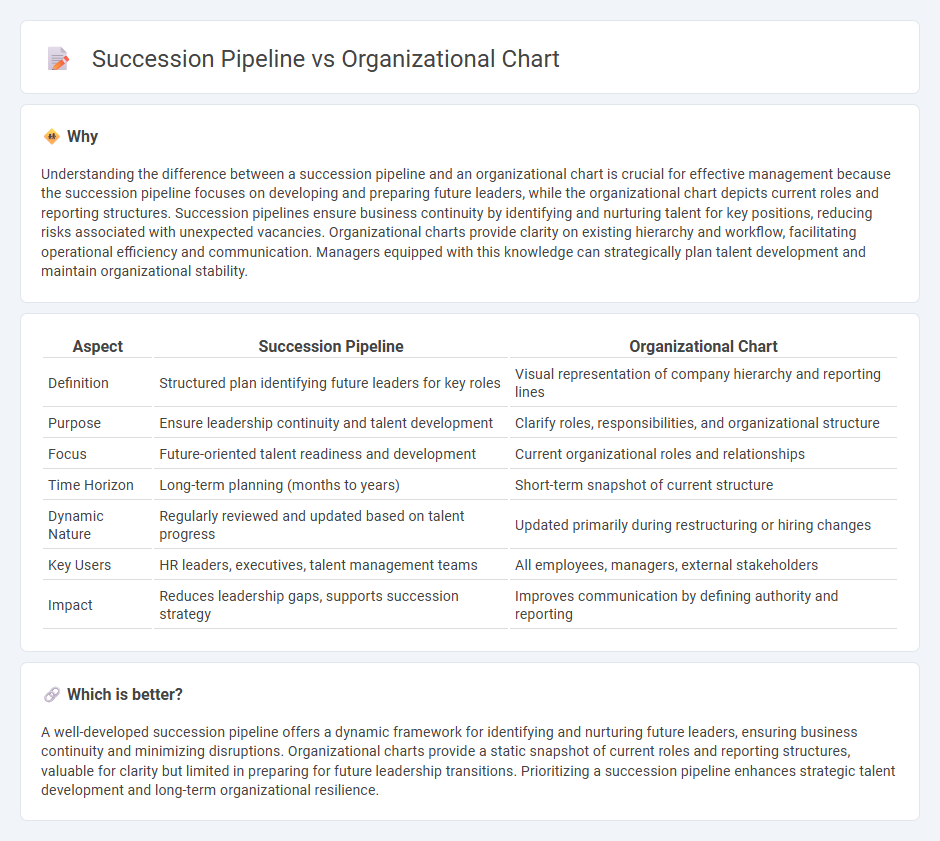
Succession pipeline focuses on identifying and developing internal talent to fill key leadership roles, ensuring business continuity and strategic growth. An organizational chart visually depicts the current hierarchy and reporting relationships within a company, clarifying roles and responsibilities. Explore how integrating succession planning with organizational charts can strengthen your management strategy.
Why it is important
Understanding the difference between a succession pipeline and an organizational chart is crucial for effective management because the succession pipeline focuses on developing and preparing future leaders, while the organizational chart depicts current roles and reporting structures. Succession pipelines ensure business continuity by identifying and nurturing talent for key positions, reducing risks associated with unexpected vacancies. Organizational charts provide clarity on existing hierarchy and workflow, facilitating operational efficiency and communication. Managers equipped with this knowledge can strategically plan talent development and maintain organizational stability.
Comparison Table
| Aspect | Succession Pipeline | Organizational Chart |
|---|---|---|
| Definition | Structured plan identifying future leaders for key roles | Visual representation of company hierarchy and reporting lines |
| Purpose | Ensure leadership continuity and talent development | Clarify roles, responsibilities, and organizational structure |
| Focus | Future-oriented talent readiness and development | Current organizational roles and relationships |
| Time Horizon | Long-term planning (months to years) | Short-term snapshot of current structure |
| Dynamic Nature | Regularly reviewed and updated based on talent progress | Updated primarily during restructuring or hiring changes |
| Key Users | HR leaders, executives, talent management teams | All employees, managers, external stakeholders |
| Impact | Reduces leadership gaps, supports succession strategy | Improves communication by defining authority and reporting |
Which is better?
A well-developed succession pipeline offers a dynamic framework for identifying and nurturing future leaders, ensuring business continuity and minimizing disruptions. Organizational charts provide a static snapshot of current roles and reporting structures, valuable for clarity but limited in preparing for future leadership transitions. Prioritizing a succession pipeline enhances strategic talent development and long-term organizational resilience.
Connection
Succession pipeline development relies on an organizational chart to identify critical roles and potential internal candidates for leadership transition. The organizational chart visually maps the hierarchy, enabling strategic planning for talent development and continuity. Aligning succession planning with the organizational structure ensures seamless leadership replacement and minimizes operational disruption.
Key Terms
Hierarchy
An organizational chart visually represents the hierarchy within a company, displaying reporting lines and the chain of command across departments. In contrast, a succession pipeline focuses on identifying and preparing high-potential employees to fill key leadership positions in the future, emphasizing talent development over structural mapping. Explore how integrating both tools enhances strategic workforce planning and leadership continuity.
Talent Development
An organizational chart visually represents the company's structure, detailing roles and reporting lines, while a succession pipeline identifies and prepares high-potential employees for future leadership positions to ensure business continuity. Talent development is central to the succession pipeline, involving targeted training, mentoring, and performance assessments to build a robust leadership bench. Explore the key strategies to effectively integrate succession planning within your organizational development framework.
Leadership Continuity
An organizational chart visually maps out a company's hierarchy and reporting structure, highlighting leadership positions and departmental relationships. In contrast, a succession pipeline strategically identifies and develops potential leaders to ensure seamless leadership continuity and minimize disruption during transitions. Explore effective strategies to build a robust succession pipeline for sustained organizational success.
Source and External Links
Organizational chart - Wikipedia - An organizational chart is a diagram that shows the structure of an organization and the relationships and ranks of its parts and positions, commonly including hierarchical, matrix, and flat types.
What is an Organizational Chart? - Miro - An organizational chart outlines how a company operates by showing relationships between roles, with common types including functional top-down, flat, and matrix structures.
What is an Organizational Chart - Lucidchart - Organizational charts show internal structure using boxes for employees or positions, with three main types: hierarchical, matrix (multiple managers per role), and flat, with relationships shown via solid or dotted lines.
 dowidth.com
dowidth.com